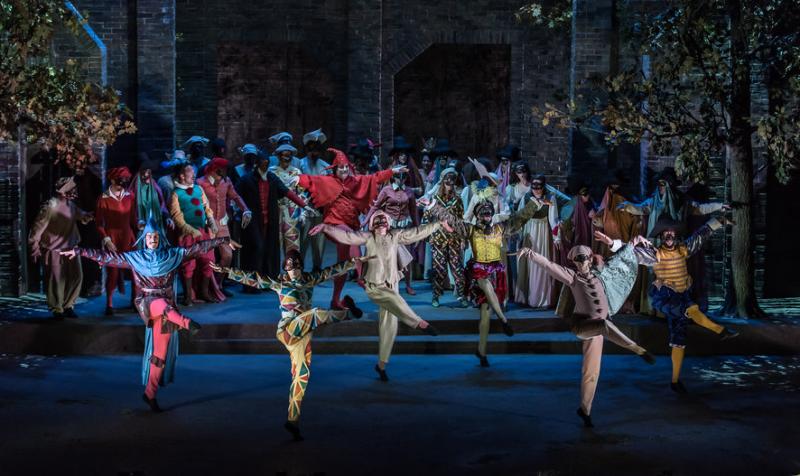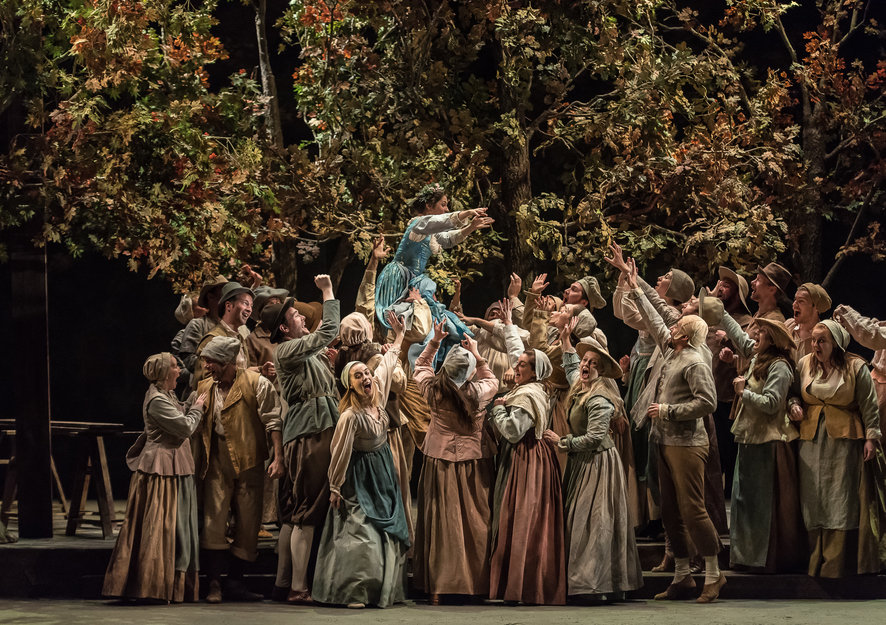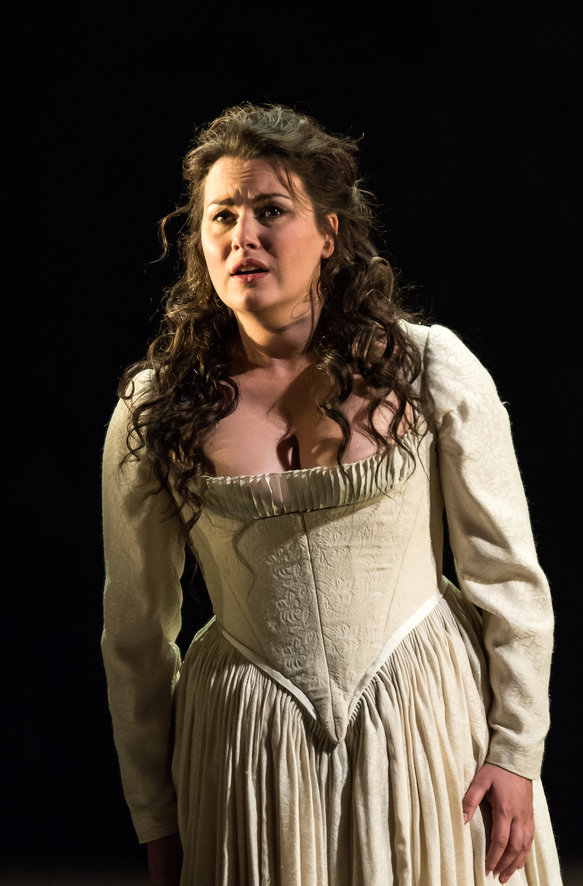Le Pré aux Clercs, Wexford Festival Opera | reviews, news & interviews
Le Pré aux Clercs, Wexford Festival Opera
Le Pré aux Clercs, Wexford Festival Opera
A French operatic delicacy is served just a little too sweet for a contemporary audience

“No courtier or lady’s champion would dream of fighting a duel anywhere else…” The setting for duels, liaisons, champagne and love, Paris’s Pré aux Clercs gives its name to Ferdinand Herold’s almost-comic 1832 opera – a welcome mood-lightener in this season’s otherwise tragic fare at the Wexford Festival.
The context – France’s 16th-century Wars of Religion – offers not only echoes of Meyerbeer’s Les Huguenots but also hints of the strife to come in a love-intrigue where religion as well as romance is at issue. Marguerite de Valois and her lady-in-waiting Isabelle are diplomatic prisoners at the French court, high-ranking bargaining counters in the conflict between the Catholic Henri III (Marguerite’s brother) and the Protestant King of Navarre (Marguerite’s husband). Though courted by the swashbuckling Comte de Comminges, Isabelle is in love with her childhood friend the Baron de Mergy. When the latter in conveniently sent as an envoy to Paris they must contrive to marry before Isabelle is forced into an alliance with Comminges against her will.
 It is impossible to overstate the popularity of Hérold’s work in France, not only in its day but right up until the mid-20th century. By 1950 Le Pré aux Clercs had racked up over 1,600 performances at the Opera-Comique – astonishing for a work that has subsequently dropped into obscurity faster than a defenestrated Frenchman. Revived here in partnership with the Palazzetto Bru Zane, the work reveals a handful of charming arias and some attractive ensembles, but fails to raise the pulse as other Wexford rarities have.
It is impossible to overstate the popularity of Hérold’s work in France, not only in its day but right up until the mid-20th century. By 1950 Le Pré aux Clercs had racked up over 1,600 performances at the Opera-Comique – astonishing for a work that has subsequently dropped into obscurity faster than a defenestrated Frenchman. Revived here in partnership with the Palazzetto Bru Zane, the work reveals a handful of charming arias and some attractive ensembles, but fails to raise the pulse as other Wexford rarities have.
Eric Ruf’s production plays it straight, giving Le Pré the pretty, period treatment. A courtly masquerade comes complete with Harlequins and Columbines, Marguerite sports a succession of impressive velvet farthingales, while a comic sub-plot between country innkeeper Nicette and her fiancé Girot comes embellished with set-piece songs and dances.
It’s all terribly charming, but coupled with Hérold’s sugary score – vividly championed here by conductor Jean-Luc Tingaud and the Wexford Festival Orchestra – I question whether it’s judged correctly for contemporary audiences. Strong performances from a fine, French-speaking cast (there’s a lot of dialogue to get through) help it remain buoyant here, however, and bring essential sincerity to the sillier proceedings.
 Act I offers little opportunity for Marie-Eve Munger’s Isabelle (pictured left) to shine, but Act II opens with an elegant cavatina-cabaletta showstopper, showing off the soprano’s effortless upper register and coloratura agility. An appealing presence, Munger carries the emotional weight of the central love story. Nico Darmanin’s Mergy works very hard, but on this second night his vocal performance was under-projected and lacking in heroic heft. It’s hard to believe in his duelling defeat of Dominique Côté’s gloriously overwrought, tightly-wound Comte de Comminges – all vocal muscularity and hot temper.
Act I offers little opportunity for Marie-Eve Munger’s Isabelle (pictured left) to shine, but Act II opens with an elegant cavatina-cabaletta showstopper, showing off the soprano’s effortless upper register and coloratura agility. An appealing presence, Munger carries the emotional weight of the central love story. Nico Darmanin’s Mergy works very hard, but on this second night his vocal performance was under-projected and lacking in heroic heft. It’s hard to believe in his duelling defeat of Dominique Côté’s gloriously overwrought, tightly-wound Comte de Comminges – all vocal muscularity and hot temper.
The role of Marguerite is more spoken than sung, but mezzo Marie Lenormand makes tremendous impact, warmly imperious as the political fairy-godmother of the piece, and adding personality to Hérold’s many trios and ensembles. Her acid interplay with Eric Huchet’s Cantarelli – the court’s bibulous Italian master of ceremonies – helps temper the opera’s more pastel-coloured pastoral moments.
Strong support from Magali Simard-Galdes’s perky, soubrette Nicette (her wedding song is a highlight) and her tetchy Girot (Tomislav Lavoie) round out the operatic picture – a Watteau or Fragonard, decorative, elegant, but ultimately unmemorable.
- Le Pré aux Clercs at Wexford Festival until 1 November 2015
rating
Explore topics
Share this article
The future of Arts Journalism
You can stop theartsdesk.com closing!
We urgently need financing to survive. Our fundraising drive has thus far raised £49,000 but we need to reach £100,000 or we will be forced to close. Please contribute here: https://gofund.me/c3f6033d
And if you can forward this information to anyone who might assist, we’d be grateful.

Subscribe to theartsdesk.com
Thank you for continuing to read our work on theartsdesk.com. For unlimited access to every article in its entirety, including our archive of more than 15,000 pieces, we're asking for £5 per month or £40 per year. We feel it's a very good deal, and hope you do too.
To take a subscription now simply click here.
And if you're looking for that extra gift for a friend or family member, why not treat them to a theartsdesk.com gift subscription?
more Opera
 La bohème, Opera North review - still young at 32
Love and separation, ecstasy and heartbreak, in masterfully updated Puccini
La bohème, Opera North review - still young at 32
Love and separation, ecstasy and heartbreak, in masterfully updated Puccini
 Albert Herring, English National Opera review - a great comedy with depths fully realised
Britten’s delight was never made for the Coliseum, but it works on its first outing there
Albert Herring, English National Opera review - a great comedy with depths fully realised
Britten’s delight was never made for the Coliseum, but it works on its first outing there
 Carmen, English National Opera review - not quite dangerous
Hopes for Niamh O’Sullivan only partly fulfilled, though much good singing throughout
Carmen, English National Opera review - not quite dangerous
Hopes for Niamh O’Sullivan only partly fulfilled, though much good singing throughout
 Giustino, Linbury Theatre review - a stylish account of a slight opera
Gods, mortals and monsters do battle in Handel's charming drama
Giustino, Linbury Theatre review - a stylish account of a slight opera
Gods, mortals and monsters do battle in Handel's charming drama
 Susanna, Opera North review - hybrid staging of a Handel oratorio
Dance and signing complement outstanding singing in a story of virtue rewarded
Susanna, Opera North review - hybrid staging of a Handel oratorio
Dance and signing complement outstanding singing in a story of virtue rewarded
 Ariodante, Opéra Garnier, Paris review - a blast of Baroque beauty
A near-perfect night at the opera
Ariodante, Opéra Garnier, Paris review - a blast of Baroque beauty
A near-perfect night at the opera
 Cinderella/La Cenerentola, English National Opera review - the truth behind the tinsel
Appealing performances cut through hyperactive stagecraft
Cinderella/La Cenerentola, English National Opera review - the truth behind the tinsel
Appealing performances cut through hyperactive stagecraft
 Tosca, Royal Opera review - Ailyn Pérez steps in as the most vivid of divas
Jakub Hrůša’s multicoloured Puccini last night found a soprano to match
Tosca, Royal Opera review - Ailyn Pérez steps in as the most vivid of divas
Jakub Hrůša’s multicoloured Puccini last night found a soprano to match
 Tosca, Welsh National Opera review - a great company reduced to brilliance
The old warhorse made special by the basics
Tosca, Welsh National Opera review - a great company reduced to brilliance
The old warhorse made special by the basics
 BBC Proms: The Marriage of Figaro, Glyndebourne Festival review - merriment and menace
Strong Proms transfer for a robust and affecting show
BBC Proms: The Marriage of Figaro, Glyndebourne Festival review - merriment and menace
Strong Proms transfer for a robust and affecting show
 BBC Proms: Suor Angelica, LSO, Pappano review - earthly passion, heavenly grief
A Sister to remember blesses Puccini's convent tragedy
BBC Proms: Suor Angelica, LSO, Pappano review - earthly passion, heavenly grief
A Sister to remember blesses Puccini's convent tragedy
 Orpheus and Eurydice, Opera Queensland/SCO, Edinburgh International Festival 2025 review - dazzling, but distracting
Eye-popping acrobatics don’t always assist in Gluck’s quest for operatic truth
Orpheus and Eurydice, Opera Queensland/SCO, Edinburgh International Festival 2025 review - dazzling, but distracting
Eye-popping acrobatics don’t always assist in Gluck’s quest for operatic truth

Add comment